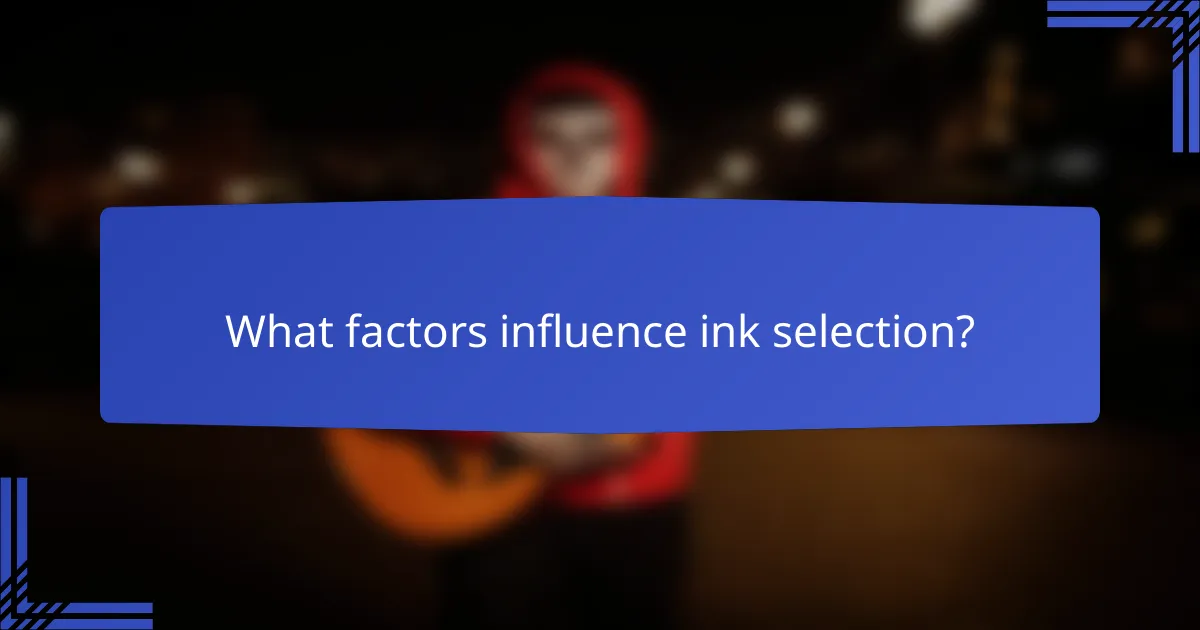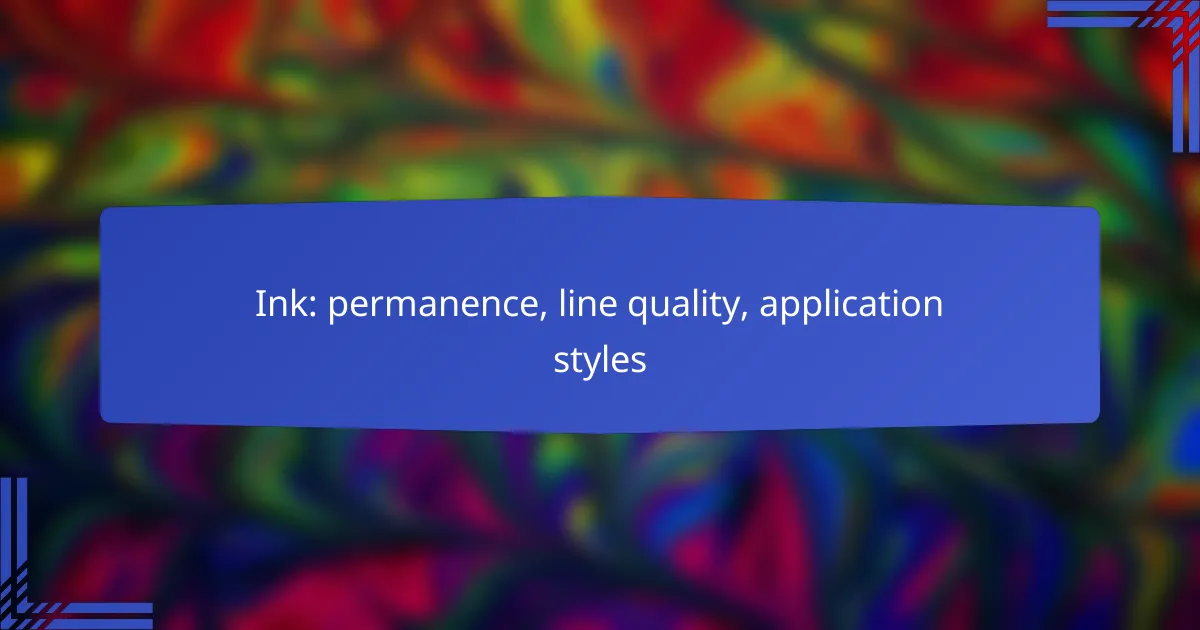Ink plays a crucial role in art and writing, with its permanence, line quality, and application styles significantly impacting the final outcome. For lasting results, artists often choose archival, pigment-based, and waterproof inks that resist fading over time. The line quality varies based on ink type and application method, influencing the smoothness and thickness of the written line. Different styles, such as calligraphy and sketching, require specific techniques that further affect the ink’s appearance and durability.

What are the best inks for permanence?
The best inks for permanence are those specifically designed to resist fading and degradation over time. Archival, pigment-based, and waterproof inks are among the top choices for artists and professionals seeking long-lasting results.
Archival inks
Archival inks are formulated to meet specific standards for longevity, often lasting decades without significant fading. These inks typically contain pigment rather than dye, which contributes to their durability and resistance to environmental factors.
When selecting archival inks, look for those that are acid-free and comply with industry standards such as ISO 9706. This ensures that the inks will not degrade the paper or other materials they are applied to.
Pigment-based inks
Pigment-based inks are known for their high lightfastness and resistance to water, making them ideal for prints and artwork that need to endure over time. Unlike dye-based inks, pigments are solid particles suspended in the ink, which helps prevent fading.
Consider using pigment-based inks for fine art prints or documents that require longevity. They may be slightly more expensive than dye-based options, but their durability often justifies the cost.
Dye-based inks
Dye-based inks offer vibrant colors and smooth application but are generally less permanent than pigment-based inks. They can fade more quickly when exposed to light and may not withstand moisture as well.
While dye-based inks are suitable for everyday printing and projects where color intensity is a priority, they are not the best choice for archival purposes. If using dye-based inks, consider storing prints in protective sleeves to extend their lifespan.
Waterproof inks
Waterproof inks are designed to resist smudging and running when exposed to water, making them ideal for outdoor applications or documents that may encounter moisture. These inks often utilize special formulations that enhance their durability.
When choosing waterproof inks, check the manufacturer’s specifications to ensure they meet your needs. They are particularly useful for labels, signage, and any work that may be subjected to wet conditions.
UV-resistant inks
UV-resistant inks are formulated to withstand ultraviolet light, which can cause fading and discoloration over time. These inks are essential for outdoor signage and artwork displayed in bright environments.
For projects exposed to sunlight, opt for UV-resistant inks to maintain color integrity. Many manufacturers offer these inks as part of their product lines, so be sure to look for this feature when making your selection.

How does line quality vary among ink types?
Line quality differs significantly among various ink types, affecting the smoothness, thickness, and overall appearance of the written line. Factors such as viscosity, drying time, and the writing instrument used play crucial roles in determining the final output.
Fountain pen ink
Fountain pen ink is typically water-based, allowing for smooth flow and a consistent line quality. The ink’s viscosity is lower than that of other types, which helps prevent skipping and promotes a rich, saturated line. However, it can take longer to dry, making it less suitable for quick notes.
When using fountain pen ink, consider the nib size; broader nibs produce thicker lines, while finer nibs yield thinner lines. Choosing high-quality ink can enhance the writing experience and improve permanence.
Gel ink
Gel ink combines the smoothness of fountain pen ink with the quick-drying properties of ballpoint ink. It provides vibrant colors and a consistent line quality, making it popular for everyday writing and art applications. The thicker consistency allows for a more controlled application, reducing the chances of smudging.
When selecting gel ink, look for options that are labeled as archival or fade-resistant if permanence is a priority. The tip size also influences line quality; finer tips create precise lines, while broader tips can produce bolder strokes.
Ballpoint ink
Ballpoint ink is oil-based, resulting in a thicker consistency that dries quickly and is less prone to smudging. This type of ink is ideal for everyday writing, as it provides durability and longevity. However, the line quality can be less smooth compared to fountain and gel inks.
For optimal performance, choose a ballpoint pen with a high-quality ball mechanism to ensure consistent ink flow. Consider the pen’s tip size; finer tips are better for detailed work, while medium to broad tips are suitable for general writing.
Marker ink
Marker ink varies widely depending on the type of marker, but it generally offers bold, saturated lines. Alcohol-based markers dry quickly and are ideal for blending, while water-based markers are easier to clean but may smudge. The line quality can be influenced by the marker’s tip shape and size.
When using markers, choose the appropriate type for your project; permanent markers are excellent for long-lasting applications, while washable markers are better for temporary use. Always test the ink on your chosen surface to ensure compatibility and desired line quality.

What application styles are popular for ink?
Popular application styles for ink include calligraphy, sketching, lettering, and painting. Each style has unique techniques and considerations that affect the final appearance and permanence of the ink used.
Calligraphy
Calligraphy is the art of beautiful handwriting, often using specialized pens or brushes to create decorative letters. It requires a steady hand and an understanding of letterforms, spacing, and flow. The choice of ink can significantly impact the final look, with archival inks being preferred for their permanence.
When practicing calligraphy, consider using smooth, high-quality paper to prevent bleeding and feathering. Experimenting with different nib sizes and ink types can also help achieve various effects, from bold strokes to delicate lines.
Sketching
Sketching with ink involves creating quick, expressive drawings that capture ideas or scenes. Artists often use fine liners, brush pens, or fountain pens to achieve different line qualities. The permanence of ink can enhance sketches, allowing for layering and mixed media applications.
To improve your ink sketching, focus on line variation and shading techniques. Using water-resistant inks can allow for additional watercolor washes without smudging, expanding your creative options.
Lettering
Lettering is the design of letters and words, often used in graphic design and illustration. Unlike calligraphy, which emphasizes fluidity, lettering focuses on the structure and style of each letter. Artists may use a variety of tools, including markers and brushes, to create unique typographic designs.
For effective lettering, practice consistency in letter height and spacing. Consider using digital tools for precision, or traditional methods like pencil sketches to plan your designs before applying ink.
Painting
Ink painting combines traditional painting techniques with ink, often resulting in bold, expressive artworks. Artists can use brushes or even dip pens to apply ink in various ways, creating textures and effects that differ from standard paint. The choice of ink can influence drying times and color saturation.
When ink painting, select the right paper to support the ink’s flow and drying characteristics. Experimenting with dilution and layering can enhance depth and richness in your artwork, while ensuring that the ink remains permanent and vibrant over time.

What factors influence ink selection?
Ink selection is influenced by several factors, including the type of paper, the intended use of the ink, and its colorfastness. Understanding these elements helps ensure that the chosen ink meets the specific requirements of a project.
Paper type
The type of paper significantly affects ink performance. For instance, glossy papers require inks that dry quickly and adhere well, while porous papers may absorb more ink, leading to a softer line quality. When selecting ink, consider whether the paper is coated or uncoated, as this will impact the ink’s appearance and durability.
Additionally, different paper weights can influence how ink spreads and dries. Heavier papers often handle more ink without warping, while lighter papers may buckle if too much ink is applied. Always test ink on the specific paper type to gauge compatibility.
Intended use
Understanding the intended use of the ink is crucial for selection. For archival purposes, choose inks that are fade-resistant and permanent, ensuring longevity. For temporary applications, such as drafting or sketching, less permanent inks may suffice.
Consider the environment where the ink will be used. Inks for outdoor use should be weather-resistant, while those for indoor art may prioritize vibrancy and blending capabilities. Always align ink properties with the project’s goals.
Colorfastness
Colorfastness refers to how well an ink maintains its color over time when exposed to light, moisture, and other environmental factors. Inks with high colorfastness are essential for artworks and documents that need to withstand fading.
When selecting ink, look for products that specify their lightfastness ratings. Inks labeled as “archival” or “lightfast” typically offer better resistance to fading. Testing inks under different lighting conditions can also help determine their suitability for your specific needs.
